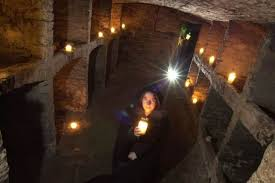Shadows Under South Bridge: The Story of Edinburgh’s Hidden Vaults
- michellebennington
- 14 minutes ago
- 4 min read

A few years ago, I had the great fortune to visit Edinburgh, Scotland. One of the sites I visited was a place called Mary King's Close, which was essentially an underground village of sorts. I'll have to write a blog post about that someday because it certainly deserves attention. Mary King's Close was the most fascinating things I'd ever seen and it has stayed with me ever since.
To my dismay, after my return home, I discovered that I had completely missed the Vaults of South Bridge in Edinburgh. I was sad to know that while I walked all up and down the Royal Mile, South Bridge, Cowgate, and Canongate, there were historical rooms, another village of sorts, beneath my feet.
Ever since learning about the vaults under Edinburgh, I became a little obsessed with them and just had to include them somehow in the third and final book of the Widows & Shadows series, Widow's Peak. I don't want to say how these vaults play a part because I fear that just mentioning this historic site will give away too much.

The Edinburgh Vaults, also known as the South Bridge Vaults were built into the nineteen arches of the South Bridge, which was completed in 1788 as part of a major city expansion. During this time of Edinburgh’s rapid growth, the South Bridge was designed to connect High Street with the University of Edinburgh on the Southside, spanning the Cowgate gorge. It was a bold architectural move, and the bridge itself became Edinburgh’s first purpose-built shopping street.
To maximize space, tenement buildings were constructed over the bridge’s arches, enclosing all but one—the Cowgate arch, which is still visible today. Behind those buildings, the hidden arches were transformed into vaults, with extra floors added to accommodate workshops, storage rooms, and other commercial uses. In total, there are about 120 rooms tucked beneath the bridge, ranging from tiny two-meter squares to cavernous forty-meter spaces.

Initially, the vaults were a practical solution for the city’s booming trades. For about thirty years, the vaults housed taverns, cobblers, and other tradespeople who needed an affordable space to work and store their goods.
Unfortunately, the bridge construction had been rushed, and the surface wasn’t properly sealed. Water seeped in, causing the vaults to become damp, dark, and increasingly inhospitable. By the 1820s, most businesses had packed up and left, and the vaults took on a far less glamorous role.

As the Industrial Revolution swept through Britain, the Cowgate area above the vaults became one of Edinburgh’s poorest neighborhoods.

The abandoned vaults were gradually taken over by the city’s most destitute residents. Families crammed into the damp, windowless rooms, living in horrific conditions: no sunlight, no running water, and no sanitation. Some rooms housed more than ten people. The air was thick and stale, and the only light came from fish oil lamps which added their own pungent aroma to the already overwhelming stench of waste and chamber pots.
In such conditions, crime quickly followed. Robbery and even murder became part of the vaults’ grim reputation. As is usually the case, illegal activities flourished in the shadows where gambling dens and unlicensed whisky distilleries operated. And, according to persistent rumors at the time, even bodysnatching gangs hid out in the vault. Reportedly, Burke and Hare, the infamous serial killers who sold their corpses to medical schools, are often linked to the vaults, though there’s no solid evidence they ever used them. (I will write about Burke and Hare in another post).

Whether Burke and Hare frequented the underground spaces or not, the vaults’ creepy atmosphere makes it easy to imagine such things happening there.
Eventually, by around the 1860s, even the slum dwellers abandoned the vaults and the underground spaces were forgotten about for over a century.
Back in the 1980s, former Scottish rugby player Norrie Rowan (left) stumbled across the long-forgotten Edinburgh Vaults. In a twist straight out of a thriller, he even used a hidden tunnel to help Romanian player Cristian Raducanu (right) escape the secret police just before the Romanian Revolution. Not exactly your average rugby retirement project.
By the 1990s, Rowan and his son Norman rolled up their sleeves and started digging out the vaults—literally. They hauled away tons of rubble by hand and uncovered all sorts of treasures: piles of oyster shells, fragments of old buildings, and even traces of people who once lived there. One room revealed terracotta tiles and a fireplace, while another held a well, offering a peek into everyday life centuries ago.
These days, the vaults have a very different vibe. On one side, they’re a hotspot for ghost tours (right), where visitors wander through candlelit chambers listening to tales of crime, poverty, and restless spirits.
On the other, they’ve been transformed into lively venues—The Caves (center) and The Rowantree (left)—hosting weddings, concerts, and Fringe Festival shows.
Of course, the ghost stories haven’t gone anywhere. But beyond the chills, the vaults remain a living slice of Edinburgh’s history—gritty, mysterious, and endlessly fascinating.

_edited.jpg)
















